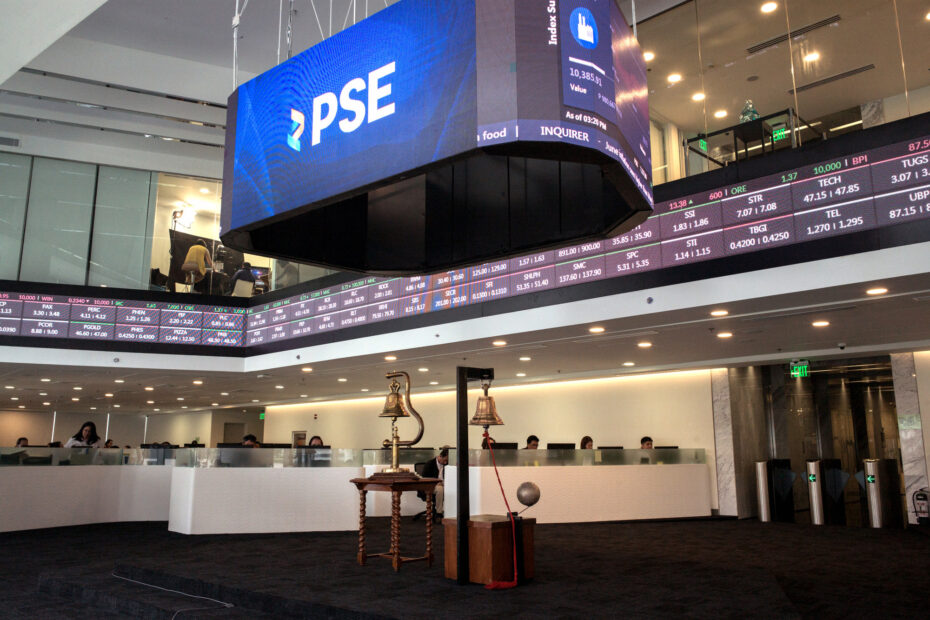THE MARKET SUMMARY
In February, stock markets experienced a notable uptick, buoyed by robust economic indicators and positive earnings reports, contributing to overall gains for the year so far. Domestic equities saw a notable surge, climbing by 4.49% throughout the month. This surge was fueled primarily by growing optimism surrounding potential monetary policy adjustments, coupled with a resurgence in the Chinese market.
However, the fixed-income market faced some challenges as investors prolonged their expectations for interest rate cuts into the latter part of 2024. Amidst the ongoing earnings season, companies largely met or exceeded market projections, further bolstering investor confidence. Additionally, economic data remained resilient, with indicators like the S&P Global Purchasing Managers’
Index (PMI) indicating continued expansion in activity throughout February.
In the Philippines, inflation continued its downward trajectory, dropping to 2.8% in January from the previous month’s 3.9%. Contrastingly, the United States saw stronger-than-expected inflation figures, with headline inflation reaching 3.1% year-on-year. This unexpected surge tempered investor expectations for Federal Reserve interest rate cuts in 2024. The stability of equity markets in February was underpinned by the continued strength of both the US and local
economies. Despite this resilience, lingering inflationary pressures suggest that central banks are likely to maintain their current monetary policies for the time being. Consequently, a prudent strategy would involve focusing on high-quality companies with robust balance sheets, especially considering that earnings projections remain optimistic.
THE STORIES THAT SHAPED THE MARKET
January Inflation
Headline inflation sharply decelerated to an over three-year low of 2.8% in January, marking the second straight month it fell within the central bank’s 2-4% target range.
Data from the Philippine Statistics Authority (PSA) showed the overall year-on-year increase in prices of widely used goods and services cooled to 2.8%in January from 3.9%in December and 8.7%in the same month in 2023.
This marked the slowest inflation print since the 2.3%seen in October 2020 amid the coronavirus pandemic. The latest consumer price index (CPI) is below the 3.1% median estimate in a poll and matched the low end of the central
bank’s 2.8-3.6%forecast.
Month on month, inflation quickened by 0.6%. Stripping out seasonality factors, month-on-month inflation declined by 0.1% in January. This inflation outturn is consistent with the central bank’s expectations that inflation will likely moderate in the first quarter of 2024 due largely to negative base effects and some easing of supply constraints affecting key commodities, the central bank said.
Core inflation, which excludes volatile prices of food and fuel, continued to ease to 3.8% in January from 4.4% in December. This is the first time that core inflation settled within the 2-4% target after 17 months and was the slowest print since 3.1% in June 2022.
National Statistician Claire Dennis S. Mapa attributed the slowdown in January inflation to the 3.5% annual increase in food and nonalcoholic beverages, slower than 5.4%in December.
Food inflation alone eased to 3.3% in January from 5.5% in the previous month and 11.2% a year ago. It marked the slowest food inflation figure since the 2.8% in March 2022.
The deceleration of food inflation last month was due to the faster decline of vegetables, tubers, plantains, cooking bananas and pulses, which was at -20.8%from -9.2%in December.
Fish and other seafood also contributed to slower food inflation, as its inflation rate eased to 1.2% in January from 4.8% seen in December.
Inflation for meat and others dropped to -0.7%from 0.2% in December.
However, rice inflation continued to accelerate. In January, rice inflation quickened to 22.6% in January from 19.6% in December. This is the highest rice inflation in nearly 15 years or since 22.9%in March 2009.
Rice was also the most significant contributor to December inflation, adding 1.3 percentage points to the 2.8% headline print. The commodity has the biggest weight in the overall CPI basket at 8.87%.
Mr. Mapa said the average price of regular milled rice jumped by 2.4% to P49.65 per kilo in January from P48.48 per kilo in December. It also rose by 25.4%from the P39.60 a kilo in January 2023.
The average price of well-milled rice also increased by 2% to P54.91 per kilo in January from an average of P53.82 per kilo a month earlier. Year on year, prices went up by 25% from P43.92 a kilo.
He also noted that the Philippines had low inflation rates for rice in the first half of 2023 before it started to spike in August and September.
National Economic and Development Authority Secretary Arsenio M. Balisacan said the Inter-Agency Committee on Inflation and Market Outlook is closely monitoring prices of rice and other commodities to provide appropriate policy
recommendations.
Mr. Balisacan also noted that the Department of Agriculture will continue to monitor on-the-ground developments in addressing food production concerns. Mr. Mapa said inflation was also driven by slower increases in housing, water, electricity, gas and other fuels, which stood at 0.7% in January, down from 1.5%in December. He said housing rentals went down in January, in contrast to what happened last year when landlords adjusted rates higher as the economy reopened.
Meanwhile, transport inflation contracted by 0.3% in January, a turnaround from the 0.4% growth in December. Inflation for financial services also declined by 0.6% from zero percent a month prior. Inflation in the National Capital Region (NCR) decelerated to 2.8% in January from the 3.5% print in December and 8.6% a year ago.
Outside of NCR, consumer prices slowed to 2.8% from 4% a month ago and 8.7% in January 2023. Inflation for the bottom 30% income households eased to 3.6% in January from 5% in December and 9.7% in the same month in 2023. According to the central bank, inflation could still accelerate to above the 2-4% target range in the second quarter due to the impact of the El Niño weather condition and positive base effects.
Key upside risks are associated with potential pressures emanating from higher transport charges, increased electricity rates, higher oil prices, and higher food prices due to strong El Niño conditions, the central bank said.
A weaker global growth and government measures to mitigate the effects of El Niño could ease some price pressures, the central bank said.
Looking ahead, the Monetary Board deems it necessary to keep monetary policy settings sufficiently tight until a sustained downtrend in inflation becomes evident, the central bank said.
The central bank will likely keep its hawkish tone despite the continued slowdown in headline inflation. Central bank Governor Eli M. Remolona, Jr. indicated that he was expecting inflation to slide in the first quarter before
accelerating sharply in the second quarter, justifying his outlook for rates to stay higher for longer.
Mr. Remolona had also said the Monetary Board may consider a rate cut in the second half this year, but inflation should be firmly within the 2-4%target. If inflation continues to moderate well into the second quarter, the central bank may be expected to begin to change their tune to signal a pivot, possibly by June.
The central bank’s tight monetary stance is working its way through the economy, as reflected with easing core inflation. But a bit of caution is warranted. Favorable base effects must fade or turn unfavorable at some point. Upside risks to inflation also linger. There are still pending petitions to hike minimum wages and transport fares, not to mention global rice prices that have yet to peak.
With growth pleasantly surprising to the upside in the fourth quarter of 2023, the central bank has the convenience of time to wait for inflation to really settle within its target band before beginning its easing cycle.
In the fourth quarter, GDP expanded by 5.6%, slower than the revised 6% GDP growth in the third quarter and the 7.1% expansion in the fourth quarter of 2022. This brought full-year GDP to 5.6%in 2023.
The central bank is also unlikely to cut ahead of the Federal Reserve. Maintaining its current rate differential with the Fed will help mitigate any volatility in the USD-PHP and prevent FX (foreign exchange) changes in re-stoking inflation. The US Federal Reserve kept borrowing costs unchanged at 5.25-5.5% since September last year, following the 525-bp rate
hikes it did from March 2022 to July 2023.
Monetary Policy
The Philippine central bank kept its benchmark interest rate – as expected – at a near 17-year high for a third straight meeting, as policymakers remained watchful despite easing consumer prices. The central bank left the target reverse repurchase rate (RRP) at 6.5% at its first policy meeting of the year, as predicted by economists in a poll. Interest rates on the overnight deposit and lending facilities were also left unchanged at 6% and 7%.
This was the third straight meeting that the central bank stood pat since its 25-basis-point off-cycle increase on Oct. 26, 2023. It raised borrowing costs by 450 basis points (bps) from May 2022 to October 2023.
In consideration of the prevailing risks, the Monetary Board deems it appropriate to keep the central bank’s monetary policy settings unchanged in the near term amid the improvement in inflation conditions, Central Bank Governor Eli M.
Remolona, Jr. said in a statement.
The central bank remains ready to adjust its monetary policy settings as necessary in keeping with its primary mandate to safeguard price stability, he added. The central bank lowered its risk-adjusted inflation forecast for 2024 to 3.9% from 4.2%, but raised its view for 2025 to 3.5% from 3.4%. It also lowered its baseline inflation forecast for this year to 3.6% from 3.7%, but kept its projection for next year at 3.2%.
Risks to the inflation outlook might have subsided, but risks are still on the upside, Mr. Remolona said. The upside risks to the inflation forecasts are linked mainly to higher transport charges, increased electricity rates, higher oil
and domestic food prices and the additional impact on food prices of a strong El Niño episode, he added.
Inflation slowed to 2.8% in January from 3.9% in December and 8.7% a year ago, the slowest since 2.3% in October 2020. It was the second straight month that inflation was within BSP’s 2-4% target.
Mr. Remolona said the recent agreement with Vietnam to secure rice supply in the next five years is encouraging. Efforts to increase rice productivity, including the distribution of drought-resistant seeds, are a step in the right direction, he added.
In January, rice inflation quickened to 22.6% from 19.6% in December, the fastest in nearly 15 years. Rice was also the most significant contributor to December inflation, adding 1.3 percentage points. The commodity had the biggest weight in the CPI basket at 8.87%. Under a deal signed during President Ferdinand R. Marcos, Jr.’s two-day state visit to Vietnam in January, Hanoi committed to supply 1.5 million to 2 million metric tons of white rice to the Philippines at a competitive and affordable price for five years.
Central bank Senior Assistant Governor Iluminada T. Sicat said there is scope for a rate cut this year as soon as they see a firmer inflation downtrend. She noted that inflation might continue to ease this quarter due to base effects, but it might pick up above the 2-4% target in the second quarter. Inflation will go back to the target in the second half, Ms. Sicat said. She also said higher-than-expected minimum wage increases in the Philippines could reverse slowing inflation.
The Philippine Senate approved on second reading a bill calling for a P100 ($1.78) across-the-board minimum wage increase for workers in the private sector. The Senate president expects the bill to be approved on third and final reading
next week. There is still a more than 50% probability of above-target inflation this year, said Dennis D. Lapid, officer-in-charge of the BSP Department of Economic Research.
Ms. Sicat also said the timing of reserve requirement ratio (RRR) cuts should be considered once inflation risks ebb. The central bank continues to maintain its commitment to reduce the RRR level at the rate of its neighbors.
The central bank said the government might miss its 6.5-7.5% economic growth target this year as the full impact of the central bank’s prior monetary policy tightening continues to manifest itself.
Finance Secretary Ralph G. Recto earlier said macroeconomic assumptions might need to be adjusted to be “more realistic.”
The economy grew by 5.6%last year, slower than 7.6% in 2022 and falling short of the state’s 6-7%goal. The central bank might start easing policy rates by the middle of the year because inflation is expected to remain within
target in the coming months. Overall, the central bank is expected to cut rates in May and lower borrowing costs by a total of 200 bps next year, which
is much more dovish than the consensus.
The central bank would likely remain hawkish and keep rates untouched until the Federal Reserve delivers its own rate cuts. However, with the risk-adjusted inflation forecast already within target, the central bank now has scope to discuss potential easing possibly as early as midyear. The central bank is expected to cut rates by 100 bps this year starting May. The base case is that growth will soften further this year to 4.8% from 5.6% in 2023, which would represent the weakest full-year outturn since 2011, barring the pandemic-induced recession in 2020.
The Philippine central bank would cut rates when it starts to see a firmer indication of disinflation. For the time being, risks are tilted to slower commencement of rate cuts given inflationary risks including weather disruptions, geopolitical tensions and possible minimum wage hikes.
MPI / SMC
Philippine conglomerates Metro Pacific Investments Corp. and San Miguel Corp. have started talks to explore combining their toll road businesses, which people familiar with the matter said would form a group worth as much as $10 billion, making it the country’s biggest-ever merger. If a deal is reached, it could also lead to the merged entity being listed on the stock exchange in Manila. The companies are also exploring other possible business combinations, including of their power and energy divisions.
Considerations are preliminary and Metro Pacific and San Miguel may decide against pursuing a merger of their assets. San Miguel issued a statement saying it is in talks with Metro Pacific on a possible joint venture for the toll road businesses.
A $10 billion merger of the toll road operations would eclipse SM Prime Holdings Inc.’s $7.3 billion acquisition of SM Land Inc. in 2013.
Metro Pacific Chairman Manuel Pangilinan said last year that his friendship with San Miguel’s President Ramon Ang could help lead to a merger of the toll road ventures and that a subsequent listing could “energize” the local stock exchange.
Metro Pacific, backed by Hong Kong-based First Pacific Co. Ltd., operates 223 kilometers (139 miles) of expressway across three major Philippine toll road systems and will add a further 72 kms in the next 5 years, according to its website. The company also has interests in power, water, health care, light rail and logistics, the website shows.
Through its SMC Infrastructure unit, San Miguel manages the construction, management and operation of projects such as the Tarlac-Pangasinan-La Union Expressway, the Southern Tagalog Arterial Road and the South Luzon Expressway, according to its website.
San Miguel is also involved in the food and beverage industry, oil refining and marketing, cement, packaging, real estate, as well as power and energy.
This Market Recap is provided by Globalinks Securities and Stocks Inc.



